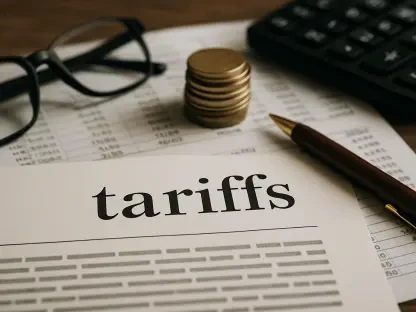The intricate world of derivatives, traditionally dominated by non-bank financial institutions and investment banks, has over the past few decades witnessed a significant transformation. U.S. commercial banks have seamlessly morphed into powerful derivatives traders due to a series of administrative decisions by unelected regulators, rather than through acts of Congress. Understanding this shift necessitates a comprehensive exploration of the history, associated risks, regulatory landscape, and potential reforms to ensure future stability.
The Role of the OCC in Redefining Banking
Historically, U.S. commercial banks adhered to a conservative approach, focusing mainly on traditional banking activities such as loans and depositor interactions. However, this began to change dramatically with the interventions of the Office of the Comptroller of the Currency (OCC), a key regulatory agency in the United States. Through numerous interpretations and expansive policy guidelines, the OCC gradually broadened the scope of what was considered permissible under the “business of banking.”
During the 1980s and 1990s, the OCC began to allow banks to engage in derivatives activities, positing that these financial instruments were essential for risk management. This regulatory shift facilitated banks’ entry into the domain of derivatives, traditionally the purview of investment banks and other financial entities. The OCC’s decisions effectively navigated around legislative limitations, leveraging regulatory flexibility to expand the banks’ exposure to derivatives. This marked the start of a significant transformation within the U.S. banking industry, allowing commercial banks to delve deeper into high-risk financial activities.
This redefinition was not entirely transparent. It involved a series of administrative actions that did not require direct legislative input. As a consequence, the regulatory adjustments redefined banking activities in a way that significantly increased systemic risk. The OCC’s expansive interpretations allowed banks to engage in activities beyond traditional banking, such as trading derivatives to hedge risks associated with commodity prices and financial markets. This maneuvering essentially enabled commercial banks to become critical players in the derivatives market, laying the groundwork for the massive, interconnected financial networks we see today.
The Dismantling of the Glass-Steagall Act
For much of the 20th century, the Glass-Steagall Act of 1933 provided a fundamental framework that separated traditional banking activities from speculative investment activities. The law aimed to protect depositors and maintain financial stability by keeping commercial and investment banking distinct. This framework worked effectively for decades, insulating traditional banking functions from the risks associated with speculative activities.
However, the regulatory landscape shifted dramatically with the repeal of key provisions of the Glass-Steagall Act through the Gramm-Leach-Bliley Act of 1999. This change, along with the passage of the Commodity Futures Modernization Act of 2000, significantly loosened the restrictions on banking activities. These legislative actions allowed commercial banks to engage in high-risk activities that were previously off-limits. By eroding the barriers between commercial and investment banking, these changes enabled banks to become deeply involved in the derivatives market, thereby amplifying their financial risks.
The dismantling of Glass-Steagall was underpinned by the OCC’s broadened definitions of permissible banking activities. The disconnect between the legislative intent of protecting depositor funds and the regulatory actions allowing speculative practices opened the door for commercial banks to undertake massive derivatives trades. As a result, banks started taking on more risks, engaging in high-stakes financial derivatives trading under the guise of risk management. This marked a pivotal transformation in the banking landscape, creating an environment where banks could significantly leverage their positions in the derivatives market.
Systemic Risk and Derivatives Interconnectedness
While derivatives are designed to hedge against financial risks, they paradoxically introduce substantial systemic risks due to their complexity and interconnectedness. The market for derivatives is valued in trillions of dollars, signifying a vast web of interlinked financial obligations. The intertwined nature of this market means that the default of a significant derivatives counterparty could trigger a cascading series of failures across the global financial system.
The interconnectedness of the derivatives market implies that a collapse of a major player could set off a domino effect, affecting numerous institutions. This would not just threaten participant banks but encompass the entire financial ecosystem. The systemic risk is exacerbated by the sheer size and complexity of the derivatives market; a single point of failure could drain liquidity across the financial system, creating a perilous situation for the broader economy. The intricacies of derivatives make them uniquely prone to igniting financial instability, highlighting the fine line between using them for hedging purposes and igniting wide-reaching systemic risk.
One critical aspect of derivatives is their prioritization under current bankruptcy laws. Derivatives are given “super-priority” status, meaning that in the event of bankruptcy, derivatives and repo trades are settled before other obligations, including depositor claims. This prioritization poses significant risks to the safety of depositor funds. It ensures that derivatives counterparties get paid first, even before secured creditors, including state and local governments. This can endanger the broader economic structure by stripping critical liquidity needed to support depositor protections and other essential financial obligations.
The “Too Big to Fail” Phenomenon
Another crucial issue in the derivatives market is concentration risk, with the vast majority of derivatives held by a handful of very large banks. As of the end of 2023, four major banks—Goldman Sachs Bank USA, JPMorgan Chase Bank N.A., Citibank, and Bank of America—held approximately 87% of all derivatives traded by U.S. banks. This high concentration exacerbates systemic risk, as the faltering of any one of these institutions could have devastating ripple effects throughout the financial system.
The “too big to fail” phenomenon indicates that these large banks are so integral to the financial system that their collapse would necessitate taxpayer-funded bailouts, as was evident during the 2008 financial crisis. This reliance on government intervention underscores the fragile nature of financial stability when dominated by a few large entities heavily involved in derivatives trading. Taxpayers, therefore, bear the brunt of rescuing these institutions in times of crisis, revealing a moral hazard issue where banks might take on excessive risks with the knowledge that they will be bailed out.
The concentration of derivatives risk effectively ties the fate of the wider economy to a few large banks. This creates a precarious balance where the failure of any of these institutions could lead to widespread financial turmoil. The significant derivatives exposure of these banks means that their setbacks could trigger a severe liquidity crunch, cascading through the interconnected network of financial institutions. Thus, the concentration risk inherent in the derivatives market calls for urgent attention and systemic reforms to mitigate potential economic fallout.
Inadequate Post-2008 Reforms
Following the 2008 financial crisis, driven largely by the meltdown of derivatives like mortgage-backed securities, several reforms were introduced to mitigate banks’ risky behaviors. The Dodd-Frank Wall Street Reform and Consumer Protection Act aimed to provide a more robust regulatory framework, with measures like the Volcker Rule designed to restrict speculative trading by commercial banks. Despite these efforts, many of the fundamental vulnerabilities associated with derivatives trading remain unaddressed, allowing banks to continue engaging in substantial derivatives activities.
Regulatory agencies like the OCC have continued to interpret banking statutes in ways that allow banks to expand their derivatives portfolios. Even as obvious high-risk practices have been curtailed, the underlying systemic risks tied to derivatives market entanglements persist. The reforms implemented post-2008 have not been comprehensive enough to address the deeper issues of interconnected risk and concentration in the derivatives market. Consequently, banks remain exposed to the same kinds of risks that precipitated the last financial crisis, maintaining a fragile equilibrium within the global financial system.
The persistence of these risks reveals the limitations of regulatory reforms in curbing risky financial behaviors. While certain overt practices have been restricted, banks have found new avenues to expand their derivatives trading. The superficial nature of these reforms highlights the need for more profound changes in regulatory practices and banking operations to mitigate systemic risks effectively. Without addressing the fundamental issues, the financial system remains susceptible to future crises stemming from the same vulnerabilities identified during the 2008 meltdown.
Prioritizing Public Interest and Safety in Banking
Ensuring that banks operate in the public interest rather than prioritizing profit through high-risk derivatives trading necessitates a significant paradigm shift. Reform proposals from scholars like Lev Menand and Morgan Ricks advocate for treating banks as public utilities with a mandate to serve public convenience and necessity. By restricting banks’ engagement in speculative derivatives trading and compelling them to focus on customer protection and productive lending, these reforms aim to safeguard financial stability.
Transforming the nature of banking from speculative activities to service-oriented operations would involve substantial legislative action, regulatory adjustments, and a commitment from banking institutions to prioritize long-term economic health. Such a shift would require redefining the role of banks to ensure their primary focus is on creating value for customers and serving the broader public interest. Moving away from high-risk derivatives trading to more stable and productive financial practices could significantly reduce systemic risks and ensure a more robust economic foundation.
Re-orienting banking practices to emphasize public interest and safety would involve instituting guidelines that prioritize depositor protection and productive lending over speculative profit-making. Legislation to restrict banks from engaging in certain high-risk activities and stringent regulatory oversight could reinforce this new paradigm. Moreover, fostering a culture within banking institutions that values long-term stability over short-term gains is essential for sustainable financial health.
Advocating for Public Banking Models
Over the past few decades, the world of derivatives, long dominated by non-bank financial institutions and investment banks, has experienced profound change. U.S. commercial banks have evolved into major players in the derivatives market, a transition driven mainly by a series of administrative decisions by unelected regulators, rather than by congressional legislation. This shift in the landscape of derivatives trading highlights the complex interplay between regulatory choices and market dynamics.
To fully grasp this transformation, it’s essential to delve into the historical context, the inherent risks involved, the current regulatory environment, and the potential avenues for reform. The evolution of the market has significant implications for financial stability and the broader economy. Understanding these elements is crucial for evaluating the potential risks and benefits that come with commercial banks’ involvement in derivatives trading.
Regulatory choices have shaped the operations of these banks, often in ways that bypass traditional legislative processes. As we look to the future, assessing these past decisions and their impacts can inform more robust and transparent regulatory frameworks, promoting a stable and equitable financial system. Hence, a thorough exploration of these topics is key to ensuring long-term economic stability in the face of an ever-evolving financial landscape.









